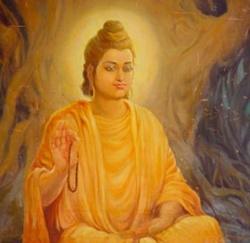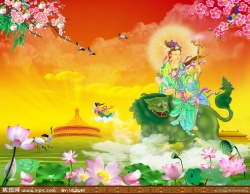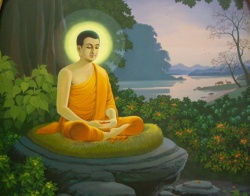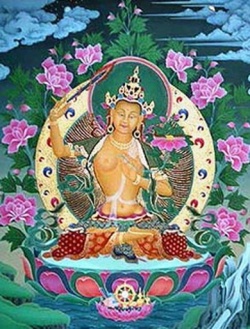Agama is a term for scriptures in Buddhism, Jainism, and Sanatana Dharma:
Agama is a term for scriptures in Buddhism, Jainism, and Sanatana Dharma:
* Hindu Agamas
* Āgama (Buddhism)
* Āgama (Jainism)
* Āgama (Hinduism)
The corresponding adjective is Agamic. Agamas are non-Vedic texts attributed to Dravidian sources as against the 'Aryan' Vedic literature. The origins of these Agamas are traceable to the days of the Indus Valley around 3000 BCE. Most of the early 'Self Realization' concepts and Yogic texts are also Agama in origin from which Tantra has branched off. Strictly speaking, Indian religious and philosophical
literature can be divided into two main streams, Agama and Vedic. The first has its roots in the early civilizations of theIndus Valley period (spread all over the sub-continent - not just Harappa and Mohenjadaro) and the second has its roots in the post Aryan period starting from about 2000-1500 BCE. From the Agama
traditions, Samkhya, Yoga and the Siddhanta philosophies evolved. Jain and Buddhist Agamas also reiterated the same philosophical ideas much later (500 BCE). From the Agama traditions also evolved parallely, the bhakti traditions involving idol worship, Linga, temple rituals, puja, goddesses like
Shakti and the legends of Shiva and Parvati. Almost all idol worship (Puja) and Temple rituals follow the Agama Vidhis (rules).
The Puranas are also influenced largely by the Agama devotional traditions. The Agamas contain sectarian and monotheistic ideas dedicated to worship of Vishnu, Shiva and Devi. For example, the Shaivite Agamas are the primary religious text in Virasaivism. The Tantras are Agama texts devoted to worship of
Devi. The Vedic traditions on the other hand, involved elaborate fire rituals (homa) invoking various nature gods like Indra, {{Wiki|Varuna]], Agni etc. The Upanishads that were later compiled along with the Vedas actually evolved as a separate branch under the influence of the Agama (Samkhya & yoga) philosophies. In this sense, almost the entire Hindu system of today can be said to be Agama in origin and not Vedic as is commonly believed.
Vedic fire rituals are now only of minor importance in a Hindu persons life as compared to the Agama Temple rituals, puja, Yoga and the Agama Siddhanta philosophies. Early Jain and Buddhist literature
are also called Agamas because they owe their origins to the same non-vedic sources. The early Agama traditions also migrated abroad from South/east India and influenced life in Indonesia where the 'Hindu Agama' religion in Java has a huge following even today. The Agamas, in spite of being the fundamental philosophical and traditional base of present day Hinduism, they have, unfortunately, not received the exposure and publicity that the Vedas have enjoyed.
In Buddhism, an āgama (Sanskrit and Pali for "sacred work" or "scripture") is a collection of Early Buddhist scriptures, of which there are five, which together comprise the various recensions of the Sūtra Pitika of the Sanskritic early schools. The various schools had different recensions of each āgama, and the five āgamas parallel the first five collections
(nikāyas) of the Sutta Piṭika of the Theravadin school's Pali Canon. Āgamas of various schools, primarily the Sarvāstivāda, are preserved in their entirety in Chinese translation, and portions also survive in Sanskrit and in Tibetan translation. In Buddhism, the term āgama is used to refer to a collection of discourses (Sanskrit: sutra; Pali: sutta) of the early Buddhist schools, which were preserved in the Chinese tradition.
These sutras correspond to the first four Nikayas of the Sutta-Pitaka of the Pali Canon, which are also occasionally called agamas. In this sense, āgama is a synonym for one of the meanings of nikaya. Many of the agama sutras belong to the Sarvāstivāda canon. Sometimes the word āgama is used to refer not to a specific scripture, but to a class of
scripture. In this case, its meaning can also encompass the Sutta-pitaka, which the Theravada tradition holds to be the oldest and most historically accurate representation of the teachings of Gautama Buddha. According to tradition, the Buddha's discourses were already collected by the time of the first council, held shortly after the Buddha's death ...
Scholars, however, see the texts as continually growing in number and size from an unknown nucleus, thereby undergoing various changes in language and content ... It is clear that, among the early schools, at a minimum the Sarvāstivāda, Kāśyapīya, Mahāsaṃghika, Dharmagupta had recensions of four of the five āgamas that differed at least somewhat. The āgamas have been compared to the Pali Canon's nikayas by contemporary scholars in an attempt to identify possible changes and root phrasings. The āgamas' existence and similarity to the Sutta Pitaka is sometimes used by scholars to assess to what degree these teachings are a historically authentic representation of the Canon of Early Buddhism. Sometimes also the differences between them are used to cast an alternative meaning on the accepted meaning of a sutta in either of the two recensions.
Four collections of āgamas appear in the Chinese Buddhist Canon used throughout East Asia: the Cháng Ahánjīng (長阿含經), the Zhōng Ahánjīng (中阿含經), the Zá Ahánjīng (雜阿含經), and the Ekottara Agama or Zēngyī Ahánjīng (增一阿含經). Complete Chinese translations of four of the five āgamas are to be found in the Chinese Buddhist Canon. There are four extant collections of āgamas, and one for which we have only references and fragments (the Kṣudrakāgama). The four extant collections are preserved in their entirety only in Chinese translation (āgama: 阿含經), although small portions of all four have recently been discovered in Sanskrit, and portions of four of the five āgamas are preserved in Tibetan.
The five Āgamas are: The Saṃyukta Āgama ("Connected Discourses", Zá Ahánjīng 雜阿含經 Taishō 99) (corresponding to Saṃyutta Nikāya). The Madhyama Āgama ("Middle-length Discourses," Zhōng Ahánjīng 中阿含經, Taishō 26)(corresponding to
Majjhima Nikāya). A complete translation of the Madhyama Āgama of the Sarvāstivāda school was done by Saṃghadeva (僧伽提婆) in the Eastern Jin dynasty (東晉) [397-398CE]. The Dīrgha Āgama ("Long Discourses," Cháng Ahánjīng 長阿含經 Taishō 1)] (corresponding to Dīgha Nikāya).
A complete version of the Dīrgha Āgama of the Dharmagupta (法藏部) school was done Buddhayaśas (佛陀耶舍) and Zhu Fonian (竺佛念) in the Late Qin dynasty (後秦) [413CE]. The Ekottara Āgama ("Increased by One Discourses," Zēngyī Ahánjīng, 增壹阿含經 Taishō 125) (corresponding to Anguttara Nikāya). A complete version, translated by Dharmanandi
(曇摩難提) of the Fu Qin state (苻秦) [397CE] and altered by Saṃghadeva in the Eastern Jin (東晉), is thought to be from either the Mahāsaṃghika (大眾部) or Sarvāstivādin canons. The Kṣudraka Āgama ("Minor Collection," corresponding to Khuddaka Nikāya) At least some schools, the Dharmaguptaka in particular, had (Kṣudraka Āgamas. The Chinese translation of the Dharmaguptaka Vinaya provides a table of contents for the Dharmaguptaka
recension of the Kṣudraka Āgama, and fragments in Gandhari appear to have been found. Agamas are canonical texts of Jainism based on Mahavira’s teachings. Mahavira’s preaching were orally compiled by his disciples into various Sutras (texts) which were collectively called Jain canonical or Agamic literature.
Traditionally these sutras were orally passed on from teachers (acaryas or gurus) to the disciples for several centuries. The scholars date the composition of Jain agamas at around 6th to 3rd century BCE. While some authors date the
composition of Jain Agamas starting from 6th Century BCE , noted indologist Hermann Jacobi holds that the composition of the Jaina canon would fall somewhere about the end of the fourth or the beginning of the third century B.C.E The general consensus
amongst scholars is that the earliest portions of Jain canons were composed around 4th or 3rd century BCE. This is also in agreement with Jain tradition according to which the agamic literature and the Purvas were passed from one heads of the order to his disciples for around 170 years after the Nirvana (Jainism) of Mahavira.
However with time, it became difficult to keep the entire Jain literature committed to memory. According to tradition, there occurred a twelve years of famine around 350 BC where it was extremely difficult for the Jain ascetics to survive during this time. Under such circumstances they could not preserve the entire canonical literature. The Purvas
or the ancient texts were already forgotten and lost after the famine. According to Svetambara tradition, the agamas were collected on the basis of collective memory of the ascetics in the first council of Pataliputra under the stewardship of Acarya Sthulibhadra in around to 463–367 BCE. However, the Digambara Jain
sect maintains that after the famine, the entire Jain canonical literature became extinct. In Hinduism, the Agamas are an enormous collection of Sanskrit scriptures which are revered. The Agamas are the primary source and
authority for yoga methods and instruction. The Shaiva Agamas revere the Ultimate Reality as Lord Shiva (Shaivism). The Vaishnava-Agamas (Pancharatra and Vaikhanasas Samhitas) adore the Ultimate Reality as Vishnu (Vaishnavism). The Shakta-Agamas (Tantras) venerate the Ultimate Reality as Shakti the consort of Shiva and Divine Mother of the universe (Shaktism).
Each set of texts expands on the central theological and philosophical teachings of that denomination. The two main schools in the Vaishnava Agama are Pancharatra and Vaikanasa Agama. The Saiva Agama has led to the Saiva Siddhanta philosophy in South India and to the Pratyabhijna system of Kashmir Saivism.
Smartas recognize the Agamas, but don't necessarily adhere to them, relying mainly on the smriti texts. In the Malay languages the word Agama literally means religion. The Agamas are also sometimes known as Tantras. Agamas deal with the philosophy and spiritual knowledge behind the worship of the deity, the yoga and
mental discipline required for this worship, and the specifics of worship offered to the deity. Each Agama consists of four parts. The first part includes the philosophical and spiritual knowledge. The second part covers the yoga and the mental discipline. The third part specifies rules for the construction of temples and for sculpting and carving the figures of deities for worship in the temples.
The fourth part of the Agamas includes rules pertaining to the observances of religious rites, rituals, and festivals. Elaborate rules are laid out in the Agamas for Silpa (the art of sculpture) describing the quality requirements of the places where temples are to be built, the kind of images to be installed, the materials from which they
are to be made, their dimensions, proportions, air circulation, lighting in the temple complex etc. The Manasara and Silpasara are some of the works dealing with these rules. The rituals followed in worship services each day at the temple also follow rules laid out in the Agamas. The Agamas state three essential requirements for a place of
pilgrimage - Sthala, Teertham and Murthy. Sthala refers to the temple, Teertham, to the temple tank and Murthy to the deity(ies) worshipped. A temple may also be associated with a tree, called the Sthala Vriksham. For instance, the Kadamba tree at the Madurai Meenakshi Sundareswarar temple is the Sthala Vriksham. A lone banyan tree that adorns the spacious courtyard of the Ratnasabha at Tiruvalankadu is the Sthala Vriksham. The entire area is believed to have been a forest of banyan trees once. Agam may refer to:
* Āgama (Buddhism)
* Jain Agamas
* Agam Regency in Indonesia




